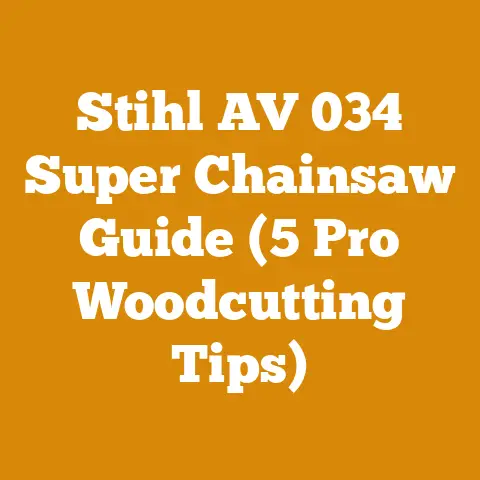Replacement Chain for Stihl MS 180C (5 Expert Tips to Choose)
Would you rather wrestle a bear for firewood or choose the perfect replacement chain for your Stihl MS 180C?
I’m betting you’d rather pick the chain!
It’s a lot less…hairy.
Choosing the right replacement chain for your Stihl MS 180C chainsaw might seem simple, but trust me, there’s more to it than meets the eye.
I’ve spent years felling trees, bucking logs, and prepping firewood, and I’ve learned firsthand how crucial the right chain is for performance, safety, and longevity.
This guide will share my expert tips to help you choose the best replacement chain.
Understanding the Importance of the Right Chain
I can’t stress this enough: the chain is the heart of your chainsaw.
It’s what transforms the engine’s power into cutting force.
The wrong chain can lead to:
- Poor Cutting Performance: A dull or mismatched chain can make even the simplest cuts a struggle.
- Increased Wear and Tear: An incompatible chain can strain your saw’s motor and components, leading to premature failure.
- Safety Hazards: A chain that’s prone to kickback or breakage can be extremely dangerous.
I’ve seen firsthand the frustration (and potential danger) of using the wrong chain.
Once, while helping a friend clear storm damage, he insisted on using an old, mismatched chain he found in his garage.
The saw vibrated excessively, cut poorly, and nearly kicked back on him – a lesson learned the hard way!
Takeaway: Investing in the right chain is an investment in your saw’s performance, your safety, and your peace of mind.
Expert Tip #1: Identifying Your Chain’s Specifications
Before you even think about buying a new chain, you need to know the exact specifications for your Stihl MS 180C.
This information is crucial to ensure compatibility.
There are three key measurements:
- Pitch: The distance between any three consecutive rivets divided by two.
Common pitches are 3/8″ low profile (often called .325″ on some saws) and .325″.
The Stihl MS 180C typically uses a 3/8″ low profile pitch. - Gauge: The thickness of the drive links, which fit into the guide bar groove.
Common gauges are .043″, .050″, .058″, and .063″.
The Stihl MS 180C usually uses a .050″ gauge. - Drive Link Count: The number of drive links that fit into the guide bar.
This is the most specific measurement and must be exact.
How to Find This Information:
- Owner’s Manual: Your Stihl MS 180C owner’s manual is the best place to find this information.
- Old Chain: If you have the old chain, you can often find the pitch and gauge stamped on the drive links.
The drive link count you will have to manually count. - Guide Bar: The guide bar might have the pitch and gauge stamped on it.
- Local Dealer: Your local Stihl dealer can quickly identify the correct chain for your saw.
I remember once trying to eyeball the chain specs for a friend’s saw.
I ended up buying the wrong chain, which was a complete waste of money and time.
Now, I always double-check the owner’s manual or consult with a professional.
Takeaway: Never guess!
Always verify the pitch, gauge, and drive link count before buying a replacement chain.
Practical Steps to Determine Chain Specifications
- Consult the Owner’s Manual: Locate your Stihl MS 180C owner’s manual.
Look for the section on chain specifications.
It will list the recommended pitch, gauge, and drive link count. - Examine the Old Chain: If you have the old chain, clean it thoroughly.
Look for markings on the drive links.
Common markings include numbers like “3/8 LP” (for 3/8″ low profile pitch) and “.050″ (for .050” gauge). - Measure the Pitch (If Markings Are Unclear): Use a caliper to measure the distance between three consecutive rivets.
Divide that number by two to get the pitch.
For example, if the distance is 0.75 inches, the pitch is 0.375 inches (which is equivalent to 3/8″ low profile). - Measure the Gauge (If Markings Are Unclear): Use a caliper to measure the thickness of a drive link.
This will give you the gauge. - Count the Drive Links: Carefully count the number of drive links on the old chain.
This is crucial for ensuring the new chain fits your guide bar.
Common Mistakes to Avoid
- Assuming All Chains Are the Same: Chainsaws come in various sizes and use different chain types.
Never assume that a chain from another saw will fit your Stihl MS 180C. - Ignoring the Drive Link Count: Even if the pitch and gauge are correct, the chain won’t fit properly if the drive link count is wrong.
- Relying on Memory: Always double-check the specifications, even if you think you remember them from the last time you bought a chain.
Expert Tip #2: Choosing the Right Chain Type for Your Needs
Not all chainsaw chains are created equal.
Different chain types are designed for specific applications.
Here are a few common types:
- Full Chisel Chains: These chains have square-cornered cutters that slice through wood quickly and efficiently.
They are ideal for clean wood and experienced users.
However, they are more prone to kickback and dull more quickly in dirty or abrasive conditions. - Semi-Chisel Chains: These chains have rounded cutters that are more forgiving and durable than full chisel chains.
They are a good choice for general-purpose cutting and are more resistant to dulling in dirty wood. - Low-Kickback Chains: These chains are designed with features that reduce the risk of kickback, such as bumper drive links or guard links.
They are a good choice for beginners or anyone concerned about safety.
For the Stihl MS 180C, which is a smaller, homeowner-grade saw, I generally recommend a low-kickback, semi-chisel chain.
This provides a good balance of cutting performance, durability, and safety.
I remember once trying to use a full chisel chain on my Stihl MS 180C while cutting some old, knotty firewood.
The chain dulled almost immediately, and the saw kept kicking back.
I quickly switched to a semi-chisel chain, and the difference was night and day.
Takeaway: Choose a chain type that matches your cutting needs and skill level.
For the Stihl MS 180C, a low-kickback, semi-chisel chain is generally a good choice.
Chain Types and Their Applications
Factors to Consider When Choosing a Chain Type
- Type of Wood: Are you cutting clean softwood, dirty hardwood, or a mix of both?
- Cutting Tasks: Are you primarily felling trees, limbing branches, or bucking firewood?
- Skill Level: Are you an experienced chainsaw user or a beginner?
- Safety Concerns: Are you concerned about kickback?
Expert Tip #3: Understanding Chain Features and Technology
Chainsaw chains aren’t just hunks of metal.
They incorporate various features and technologies designed to improve performance, safety, and durability.
Here are a few to consider:
- Bumper Drive Links: These links help reduce kickback by cushioning the impact of the chain on the wood.
- Oilomatic® Lubrication System: Stihl’s Oilomatic® system is designed to deliver oil directly to the chain links, reducing friction and wear.
- Chrome-Plated Cutters: Chrome plating increases the hardness and durability of the cutters, extending the chain’s lifespan.
- Vibration Reduction: Some chains are designed with features that reduce vibration, making the saw more comfortable to use.
When choosing a chain for your Stihl MS 180C, look for features that will enhance its performance and longevity.
I’ve found that chains with chrome-plated cutters and the Oilomatic® lubrication system tend to last longer and require less maintenance.
Takeaway: Pay attention to the features and technology incorporated into the chain.
Look for features that will improve performance, safety, and durability.






